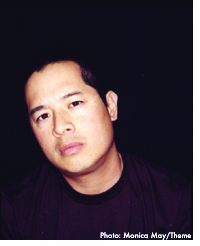 Director of the Office of Research and Analysis, National Endowment for the Arts
Director of the Office of Research and Analysis, National Endowment for the Arts
What’s the piece of news this week that is forefront on your mind when you think about technology, policy, and the arts?
I haven’t been following this as closely as I would like, but there is of course the Google Books verdict. The whole idea that gets to the heart of Google decision: balancing the really exciting and delicious opportunities for getting more access to art online with the need for artist rights – in this case authors rights. It has been interesting to read the arguments.
Why do you think this issue is relevant to the arts community?
I think there is a lot of discussion within the arts community about things like how intellectual property law needs modernization – or is it in fact where it should be? – in the face of the many more expansive opportunities to engage with art and also create art because of technology.
One of the places where the more expansive opportunities to engage with art comes up most frequently in our own work is the Survey of Public Participation in the Arts. We survey for example about many types of performance, how people participate in performances, or even create art. But what about things like mixing or remixing? Or what people in the arts sector call the curatorial aspects of the arts? Remixing may not be viewed by some as curatorial, some might view it as straight up creation or performance.
What are some exciting things happening in the nonprofit arts sector with respect to technology, policy or research?
On Friday the National Council on the Arts meeting had some really interesting presentations. One of them was from the New World Symphony, who showed us some amazing things they had done with wall screens. For me, this presentation really raised questions about the traditional infrastructure needed for arts organizations or for arts venues. You know the idea that you have this portable aspect that can occur anywhere. In one sense it could be venue neutral because you have a technology that enables presentation of art in a variety of different kinds of settings. And that’s really interesting and it changes the way we think about where art is consumed or enjoyed, and how to facilitate that. And of course there is a cost issue with that too. Does that mean ultimately these organizations are going to have more costs and will need more infrastructure to do these kinds of things? Or can these types of innovations happen relatively cheaply through more inexpensive media platforms?
Why is this exciting to you?
You’re just seeing much more of an understanding across the field. I’m glad that the NEA in a small way has been able to contribute to that understanding through the research we’ve done showing a strong connection between people who participate in the arts through, say, more traditional forms and through media. You know this from our report Audience 2.0: How Technology Influences Arts Participation. This study found that when we controlled for other factors, people who used digital media to engage with the arts or electronic media to engage with the arts are 2-3 times as likely as non-arts-media users to actually go to live events and to create art of their own.
I think there is a symbiosis here. It might be bold to say symbiosis. We can’t show any cause/effect relationship but certainly people are starting to understand the same values that drive people to go on the computer and look up art or engage with the art through electronic media are really what’s ruling demand for arts in other settings and other experiences. For example the whole idea of interactivity. That people are engaged in a way they can respond back in a way to the artwork or comment on it. They can do their own mixing as we just talked about. Their own curating. That freedom, the choice that is reflected in these kinds of values is exactly what in many ways more traditional live arts more traditional live events are trying to emulate.
Fairs and festivals are a good example. These have been going on for many years. Performing arts festivals for example or visual arts fairs or festivals basically realize that part of the reason people go to these things is because they have that interactive element that you don’t necessarily get at some kinds of arts events. At a fair or festival there is a freedom to choose the kinds of events you see. You have options. It’s kind of a smorgasbord of arts events in one place. And there is freedom of movement. All of these things that in other context you can think of as purely internet-related are virtues you see people programming in many kinds of more traditional arts experiences.
What do you see as a major challenge for the arts sector with respect to technology and copyright policy?
That’s an issue we certainly want to look at further. Our office hasn’t focused on it very closely the last few years. We are like a lot of people in the nation, who are still catching up with the technology and understanding what is permissible, what isn’t permissible and how do we ensure that the contributions of artists is recognized appropriately.
What do you think needs to happen to overcome the challenge?
A lot of it has to do with people’s ability to focus on an issue for a long period of time and having the resources to give it its due weight. But clearly this is an area that has so many cross-cutting interests. Getting people to talk about these issues and with a wide range of interests at the table – building a broad coalition – is probably what is needed to make a difference in this area.
Do you have a latest toy that you’re playing with that you’d like to comment on?
I recently got an e-reader for my dad and he’s become overnight almost a much more voracious reader. And he’s going back to his old syllabi, things that he was assigned to read in college – maybe for nostalgia or something – and he never got around to reading. So he’s really enjoying all that and I’m really tickled by his enthusiasm.
Anything you are working on that you would like to share?
We’ve been looking at the way Americans spend their time on arts activities – whether it’s going to arts events or doing arts and crafts. We’re starting to see some interesting things. Analogous with consumer spending patterns we’re seeing how people are spending their time doing art in the course of a day even.
For me, one of the big unanswered and unexplored questions is this. Lets say that one of the core attributes of art is that is provides a space to reflect, and creates a safe space for people to really engage with something in a sustained way. How is that impacted by this immediacy of art through media, this emerging environment where people can instantly interact with art?
Just like how the 24-hour news cycle was started with CNN, there is a similar cycle in terms of appreciation and enjoyment of art that is becoming shorter and shorter. How does that change the way we appreciate, respond to and understand art? We now have the ability to access anything almost at the drop of a hat and juxtopose different artworks with other kinds of art works. I wonder how the meditative quality of art will fare over the long term.
Follow the NEA’s work: Website, Twitter, Facebook, YouTube

